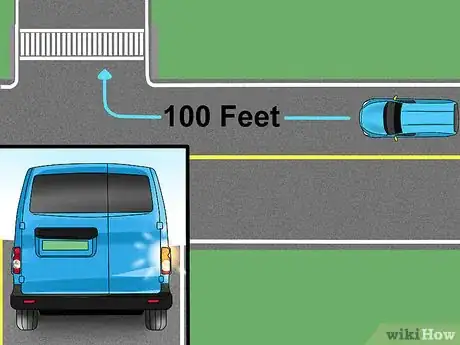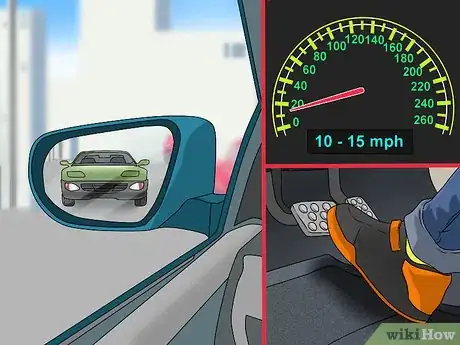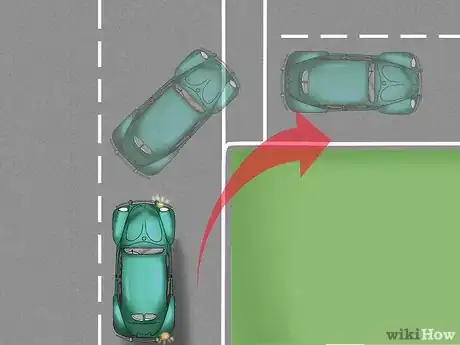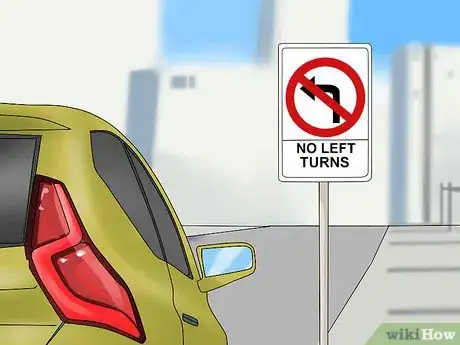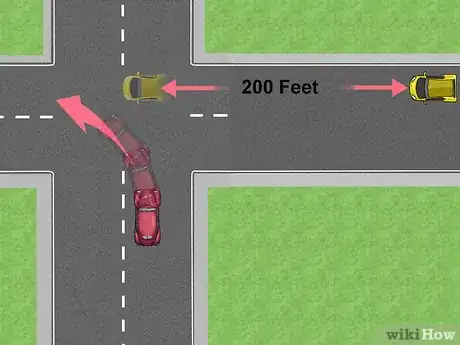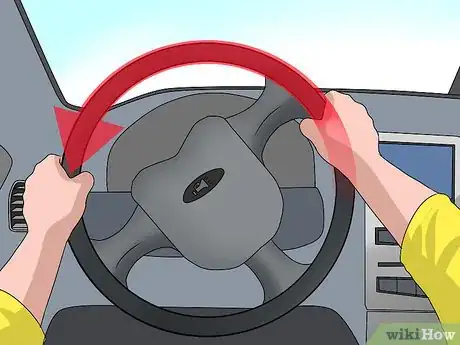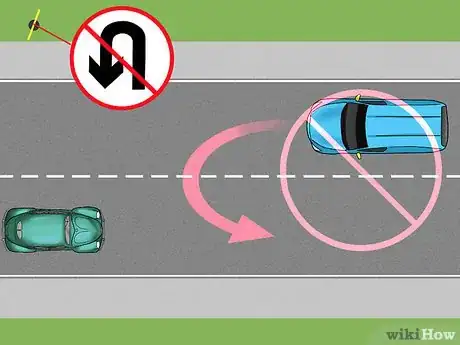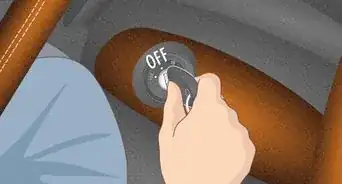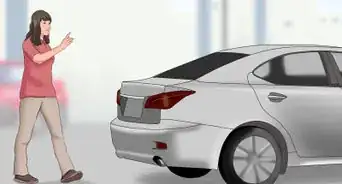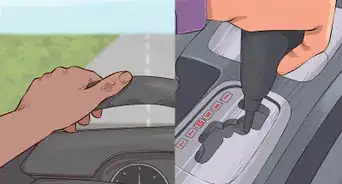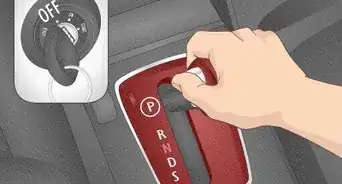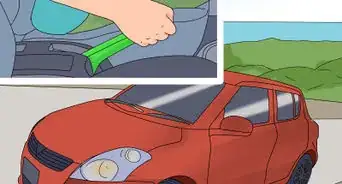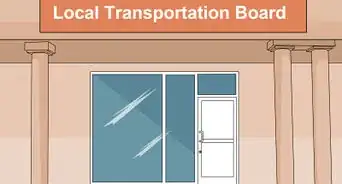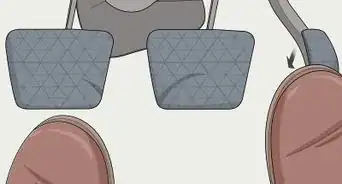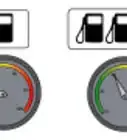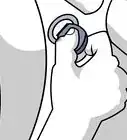This article was co-authored by Simon Miyerov. Simon Miyerov is the President and Driving Instructor for Drive Rite Academy, a driving academy based out of New York City. Simon has over 8 years of driving instruction experience. His mission is to ensure the safety of everyday drivers and continue to make New York a safer and efficient driving environment.
This article has been viewed 338,779 times.
Making proper right turns, left turns, and U-turns just takes practice. When making turns, always remember to turn on your blinker, reduce your speed, and check for oncoming traffic and pedestrians. When making U-turns, make sure to check for road signs to see if they are allowed.
Steps
Making a Right Turn
-
1Put your blinker on. Turn it on 100 feet (30 meters) or one whole city block before the turn. As you approach the turn, drive closer to the right side of the street. This will signal to cars that you are preparing to turn ahead.[1]
-
2Reduce your speed to 10 to 15 mph (16 to 24 kph). Do this by placing your foot on the brake pedal. As you reduce your speed, glance at your rear view and right-hand mirror to see if the cars behind you are slowing down.[2]
- If you notice that the cars behind you are not slowing down, tap your break pedal a couple times to signal that you are braking.
Advertisement -
3Check for pedestrians, cyclists, motorcycles, and other vehicles. Do this by looking into your right-hand mirror and by looking back over your right shoulder. Once your path is clear, make the right turn by turning your steering wheel to the right.[3]EXPERT TIPSimon Miyerov is the President and Driving Instructor for Drive Rite Academy, a driving academy based out of New York City. Simon has over 8 years of driving instruction experience. His mission is to ensure the safety of everyday drivers and continue to make New York a safer and efficient driving environment.Driving Instructor

 Simon Miyerov
Simon Miyerov
Driving InstructorOur Expert Agrees: The most important thing you have to do when you're making a U-turn is to look everywhere—look to your left, behind you, and over your right shoulder before the turn, and check your rearview mirror as you complete the turn.
-
4Turn into the right lane. Not the left lane if you are turning into a two-lane street. Try to make your turn as tight as possible without hitting the curb. In other words, do not make a wide, sweeping turn. Making wide turns may cause you to go into the lanes of oncoming traffic.[4]
- Do not make a right turn from a left lane.
Turning Left
-
1Pay attention to the road signs. You want to do this because left turns aren’t always allowed. If you see a sign saying that a left turn is illegal, then keep driving until you can make a legal left turn.[5]
- For example, some traffic lights and intersections prohibit left turns.
-
2Turn on your blinker. Do this at least 100 feet (30 meters) before the actual turn. As you approach the turn, reduce your speed to 10 to 15 miles per hour (16 to 24 kph) by pressing the break pedal. Get as close to the centerline or median as possible.[6]
- Use the center left lane if one is available to make your left turn.
- Do not attempt to make a left turn from a right lane.
-
3Come to a complete stop and yield to oncoming traffic. As you are yielding, keep your wheels straight by holding your steering wheel straight. If your wheels are slightly turned to the left while waiting, you may be shoved into oncoming traffic if a car hits you from behind.[7]
-
4Turn left once the oncoming lanes are clear. As a rule of thumb, do not turn if oncoming vehicles are less than 200 feet (60 meters) away from you. Once the lanes are clear, you may turn into either the left or right-hand lane if you are turning into a two-lane street.[8]
- If you are turning into a single-lane street, make sure to not cut the corner of the oncoming traffic’s lane. In other words, do not make your left turn too tight.
Making a U-Turn
-
1Check for signs prohibiting U-turns. You may make U-turns only if you are crossing a double yellow line, there is a “U-turn Only” sign, you are in a residential area, and if you are in the far left lane and no sign is prohibiting U-turns.[9]
- You may also make a U-turn on a divided highway if there is an opening in the center divider and the opening is not reserved for law enforcement or emergency vehicles.
-
2Turn your left signal on and reduce your speed. Once you approach your turn, get as close to the centerline of the road as possible and come to a complete stop. Observe the traffic and check for oncoming vehicles and motorcycles, as well as pedestrians and bicycles.[10]
- Oncoming vehicles must be more than 200 feet (60 meters) away before making a U-turn.
- Do not make a U-turn from the right lane.
-
3Turn you steering wheel to the left as far as you can. Do this to prepare for the U-turn. Once the lanes are clear, slightly accelerate and let the steering wheel correct itself to a straight position. Then turn into the left lane.[11]
- Do not turn into the far right lane.
-
4Avoid making illegal U-turns. U-turns are prohibited when there is a “No U-turn” sign, you are on a one-way street, and when you cannot see 200 feet (60 meters) in either direction (because of hills, curves, rain, snow, fog, and other obstacles).[12]
- Additionally, do not make U-turns on highways that are split by curbs, two sets of double yellow lines, and other dividing mechanisms.
Community Q&A
-
QuestionHow do I use the brake and the gas pedal when I am turning?
 Community AnswerWhen preparing to turn, put your foot on the brake. Ease off the brake and press the gas pedal lightly as you begin to turn. Merge into the flow of traffic as quickly as possible.
Community AnswerWhen preparing to turn, put your foot on the brake. Ease off the brake and press the gas pedal lightly as you begin to turn. Merge into the flow of traffic as quickly as possible. -
QuestionIs it against the law to not signal when making turns or changing lanes?
 Community AnswerIt depends on which state you are residing in. Check your state's driving guidelines. However, as a general rule of thumb, you should always turn on your blinker when turning.
Community AnswerIt depends on which state you are residing in. Check your state's driving guidelines. However, as a general rule of thumb, you should always turn on your blinker when turning. -
QuestionHow do I turn without being close to the curb or almost running into the other car?
 Community AnswerIf you're going to make a turn, drive until the curb is in line with the side of your car. Once you've done that, you can start to steer around making your turn.
Community AnswerIf you're going to make a turn, drive until the curb is in line with the side of your car. Once you've done that, you can start to steer around making your turn.
References
- ↑ https://www.dmv.ca.gov/portal/dmv/detail/pubs/hdbk/turns
- ↑ https://www.dmv.ca.gov/portal/dmv/detail/pubs/hdbk/turns
- ↑ https://dmv.ny.gov/about-dmv/chapter-5-intersections-and-turns#mke-trn
- ↑ https://dmv.ny.gov/about-dmv/chapter-5-intersections-and-turns#mke-trn
- ↑ https://www.dmv.ca.gov/portal/dmv/detail/pubs/hdbk/turns
- ↑ https://www.defensivedriving.com/safe-driver-resources/how-to-make-right-left-and-u-turns/
- ↑ https://dmv.ny.gov/about-dmv/chapter-5-intersections-and-turns#mke-trn
- ↑ https://www.dmv.ca.gov/portal/dmv/detail/pubs/hdbk/turns
- ↑ https://www.idrivesafely.com/driving-resources/how-to/u-turn/
About This Article
To make a right turn, start by putting your blinker on about 100 feet before the turn and driving slightly closer to the right side of the street. As you approach the turn, reduce your speed to 10 to 15 miles per hour and check your mirrors for pedestrians, cyclists, or other vehicles that might be in your path. Finally, take the turn as tight as possible to avoid going into the left lane. For left turns, make sure to come to a complete stop before turning, as you need to yield to oncoming traffic. While you wait, keep your wheels straight, or you may get pushed into oncoming traffic if someone hits you from behind. Once the oncoming lanes are clear, take the turn. For more help, like how to make a U turn, read on.
